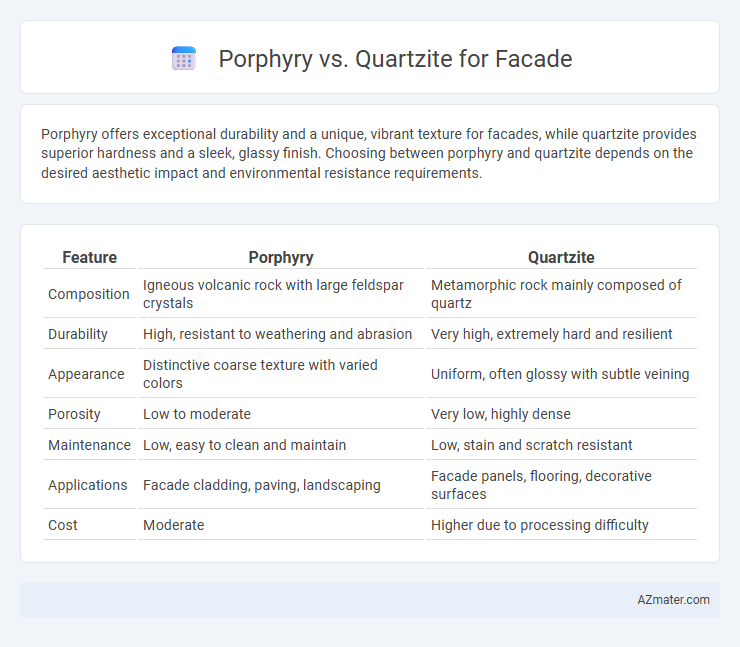Porphyry offers exceptional durability and a unique, vibrant texture for facades, while quartzite provides superior hardness and a sleek, glassy finish. Choosing between porphyry and quartzite depends on the desired aesthetic impact and environmental resistance requirements.
Table of Comparison
| Feature | Porphyry | Quartzite |
|---|---|---|
| Composition | Igneous volcanic rock with large feldspar crystals | Metamorphic rock mainly composed of quartz |
| Durability | High, resistant to weathering and abrasion | Very high, extremely hard and resilient |
| Appearance | Distinctive coarse texture with varied colors | Uniform, often glossy with subtle veining |
| Porosity | Low to moderate | Very low, highly dense |
| Maintenance | Low, easy to clean and maintain | Low, stain and scratch resistant |
| Applications | Facade cladding, paving, landscaping | Facade panels, flooring, decorative surfaces |
| Cost | Moderate | Higher due to processing difficulty |
Introduction: Porphyry vs Quartzite Facades
Porphyry and quartzite are two popular natural stones used for facades, each offering distinct aesthetic and functional benefits. Porphyry is renowned for its rich textures and durability, providing a rustic yet elegant appearance, while quartzite boasts exceptional hardness and a smooth, consistent surface ideal for modern architectural designs. Choosing between porphyry and quartzite facades depends on factors such as weather resistance, maintenance requirements, and desired visual impact.
Geological Origins and Composition
Porphyry originates from volcanic magma that cools slowly, creating large, visible crystals of feldspar or quartz embedded in a fine-grained matrix, making it highly durable and resistant to weathering. Quartzite forms from the metamorphism of pure quartz sandstone under intense heat and pressure, resulting in an extremely hard, non-porous stone composed primarily of interlocking quartz grains. The distinct geological origins influence their facade applications, where porphyry's texture provides a rugged aesthetic and quartzite offers a sleek, uniform appearance with superior hardness.
Aesthetic Differences: Color and Texture
Porphyry offers a distinct aesthetic with its coarse-grained texture and rich, vibrant colors ranging from deep reds and purples to earthy browns, creating a striking visual impact for facades. Quartzite, in contrast, features a smoother, more uniform texture with a color palette that spans soft whites, grays, and subtle blues, lending a sleek and modern appearance. The interplay of Porphyry's rugged, speckled surface versus Quartzite's refined grain influences architectural styles, with Porphyry emphasizing bold, natural drama and Quartzite providing understated elegance.
Durability and Weather Resistance
Porphyry exhibits exceptional durability and weather resistance due to its fine-grained, igneous composition, making it ideal for facades exposed to harsh environmental conditions. Quartzite offers high hardness and resistance to abrasion but can be more prone to surface weathering and oxidation when compared directly to porphyry. Selecting porphyry for facade cladding ensures long-lasting structural integrity and minimal maintenance costs in varying climates.
Maintenance Requirements
Porphyry requires minimal maintenance due to its high durability and natural resistance to weathering, making it ideal for long-lasting facades. Quartzite, while also durable, demands more frequent sealing and cleaning to prevent staining and preserve its polished appearance. Regular inspection and appropriate care for both materials ensure longevity and aesthetic appeal on building exteriors.
Installation Techniques and Complexity
Porphyry facades require specialized installation techniques due to the stone's hardness and natural fissures, often involving precise cutting and anchoring systems to prevent cracking. Quartzite, while also hard and durable, allows for slightly simpler installation methods with standard mechanical anchors and adhesives, reducing labor complexity. The choice between Porphyry and Quartzite impacts project timelines and costs, as Porphyry demands expert handling and customized fixtures, whereas Quartzite installation is generally more straightforward and cost-efficient.
Environmental Sustainability
Porphyry offers superior environmental sustainability for facades due to its natural durability and low maintenance requirements, reducing the need for frequent replacement and resource consumption. Quartzite, while also durable, often undergoes extensive quarrying and processing that can increase its carbon footprint. Choosing porphyry promotes longer lifespan and energy efficiency, making it a more eco-friendly option for sustainable building exteriors.
Cost Comparison and Budget Considerations
Porphyry typically commands a higher initial cost than quartzite due to its rarity and unique coloration, impacting overall facade project budgets. Quartzite offers a more budget-friendly alternative with robust durability and a wide range of colors, providing cost savings in both material and installation. When planning a facade, consider quartzite for lower upfront expenses and porphyry for premium aesthetics that may justify higher investment through long-term value.
Popular Applications in Modern Architecture
Porphyry is favored in modern architecture for facades due to its unique coarse-grained texture and durability, making it ideal for high-traffic urban buildings and heritage restorations. Quartzite offers remarkable hardness and resistance to weathering, commonly used in sleek, minimalist building exteriors where a smooth, consistent appearance is desired. Both materials provide excellent thermal insulation and low maintenance, contributing to energy-efficient and sustainable facade designs in commercial and residential projects.
Choosing the Right Stone for Your Facade
Porphyry offers exceptional durability and rich, vibrant colors, making it ideal for high-impact facades that require longevity and visual appeal. Quartzite provides superior hardness and a natural, elegant look with excellent resistance to weathering, suitable for modern architectural designs. Selecting between porphyry and quartzite depends on your facade's exposure conditions, desired aesthetic, and maintenance preferences.

Infographic: Porphyry vs Quartzite for Facade
 azmater.com
azmater.com